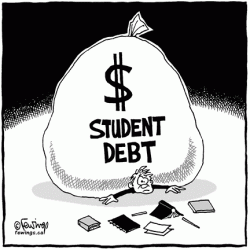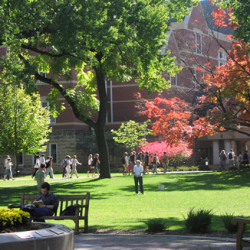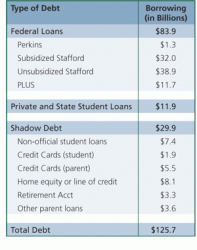
The Department of Education is going to forgive an additional $6.2 billion in student loans for 100,000 students through the Public Service Loan Forgiveness program. This adds to the $1 billion in previously forgiven loans for 11,000 students. This shows one of the reasons why student loan forgiveness is such a bad idea. Under the […]
Read More
In mid September, the Congressional duo of George Miller and John Tierney joined their Senate colleagues Tom Harkin and Dick Durbin and the Department of Education in what might be described as the ongoing Beltway Witch Trials, where the alleged witches are the colleges that are legally organized on a profit-making basis. Messrs. Miller and […]
Read More
The vast majority of American colleges and universities make admission decisions without considering the financial need of applicants. Only a handful of private institutions admit their entire first-year class need-blind and then fully meet the financial need of all of their admitted students through a combination of grants, loans and employment opportunities. These institutions tend […]
Read More
Originally posted at Open Market The Washington Times takes note of the burgeoning higher education bubble in a recent editorial: The cost of a college education has soared far in excess of the cost of health care. This is in spite of — or, more accurately, because of — massive government involvement in subsidizing […]
Read More
By Robert Weissberg America’s huge investment in higher education has always had a democratic justification: everyone should be able to attend college because this opportunity would flatten the social pyramid. Yes, a North Dakota State and Harvard degree differ in prestige, but at least the North Dakota State graduate can join the game. Put ideologically, […]
Read More
The new Sallie Mae-Gallup survey of attitudes toward higher education, “How America Pays for College 2012,” shows that Americans are becoming increasingly resistant to rising college prices. Some people who were saying “I want the best college money can buy” a few years ago, are now saying “We aren’t going to pay sky-high tuition when […]
Read More
When asked the question, “Why do colleges keep raising tuition fees?” I give answers ranging from three words (“because they can”), to 85,000 (my book, Going Broke By Degree). Avoiding both extremes, let’s evaluate two rival explanations for the college cost explosion, followed by 12 key expressions that add more detail.
Read More
Carol Todd of Nottingham, Maryland, persuaded a bankruptcy judge in Baltimore to “discharge”–that is, wipe the slate clean on–nearly $340,000 in student loan debt. The grounds were that she has Asperger’s Syndrome, a mild form of autism that apparently prevents her from getting or keeping a steady job. U.S. Bankruptcy Judge Robert Gordon ruled on […]
Read More
No modern-day Paul Revere is taking a midnight ride to warn about this, but the defaults are coming. Many are already here. They are coming from student loans given to the wrong students for the wrong reasons. The portfolio of federally guaranteed student loans passed the one trillion dollar mark in early 2012, and it […]
Read More
It’s called “the Bennett Hypothesis,” and it explains–or tries to explain–why the cost of college lies so tantalizingly out of reach for so many. In 1987, then Secretary of Education William J. Bennett launched a quarter century of debate by saying, in effect, “Federal aid doesn’t help; colleges and universities just cream off the extra […]
Read More
There’s something even worse than undergraduate debt. It’s graduate-school debt. According to the American Student Assistance website, which uses figures from such sources as the National Center for Education Statistics, the College Board, and the nonprofit Finaid.org, 60 percent of recipients of bachelor’s’ degrees borrowed to fund their education during the 2000s, with the average […]
Read More
When individuals seek higher education, why should all of us have to pay? After all, individuals decide whether to seek a college degree based on their own calculations of expected costs and benefits. That taxpayers must bear the burden of financial aid to these individuals seems unfair. Given the billions of dollars governments pay individuals […]
Read More
Sometimes the left is onto something. Take, for example, the latest twist in the “Occupy” movement: Occupy Student Debt. The new activism front, which began in with a Nov. 21 rally at Occupy Ground Zero, New York’s Zuccotti Park, is trying to collect a million online signatures from debtors pledging to refuse to repay their […]
Read More
In a recent essay in The Atlantic, Andrew Hacker and Claudia Dreifus lament that most students have to take out college loans. They write: “At colleges lacking rich endowments, budgeting is based on turning a generation of young people into debtors.” While Hacker and Dreifus blame the universities for encouraging students to take on more […]
Read More
Are for-profit colleges and universities getting a raw deal from the government compared to their more elitist peers in the private non-profit sector of American higher education? Vance H. Fried, writing in a recent policy analysis brief published by the libertarian think-tank, the Cato Foundation, argues just that. Fried is a former private-practice attorney, oil […]
Read More
The Center for College Affordability and Productivity has published an important report, “Faculty Productivity and Costs at the University of Texas at Austin,” based on data recently made available to the public, thanks to the efforts of reform-supporting regents at the UT system. Co-authored by Richard Vedder (the Ohio University economist), Christopher Matgouranis and Jonathan Robe, the report uses […]
Read More
By Andrew Gillen, Matthew Denhart, and Jonathan Robe As they defend tuition increases to irate students and parents, college and university leaders often argue that tuition does not cover their costs and that they are therefore subsidizing their students’ educations. Take, for example, what Southwestern College President Dick Merriman said in an October 2010 piece for The Chronicle of Higher […]
Read More
Today the Obama Administration unveiled its long-anticipated and highly controversial final gainful employment (GE) regulation that ties program eligibility for federal student aid to new metrics that are based on student loan repayment rates. Under the new GE rule, a vocational program can qualify as leading to gainful employment and remain eligible for federal aid […]
Read More
Tuition pricing for college is a strange business, combining a big sticker price (which few people actually pay) with big discounts in the form of institutional grants (which most people should know enough to negotiate). College pricing is even stranger than the car business. Automobile dealerships aren’t likely to give one customer a sales discount […]
Read More
At the beginning of 2011 the portfolio of the federal government for education loans was nearly one trillion dollars. The portfolio consisted of loans for students currently in college extended either directly by the Department of Education or loans from financial institutions like Sallie Mae and banks with repayment guaranteed by the United States Treasury […]
Read More
In recent years Syracuse University has decided to make its undergraduate student body more “diverse” and “inclusive”–code words for racial preferences that translated into a freshman class for the fall of 2010 that was 30 percent black and Latino. The class of 2014 was also 26 percent eligible for federal Pell grants to low-income students. […]
Read More
I’ve argued that there’s a way for-profit colleges to increase their credibility as genuine educational institutions rather than dropout factories running on federal student aid: they could focus their efforts and investment dollars on creating high-quality courses and courseware that the non-profit world might respect. And now, one for-profit institution, Capella University, seems to be […]
Read More
For-profit colleges are having a tough time these days, thanks to the Obama Education Department’s looming new “gainful employment” rules that threaten federal aid cutoffs to an industry that derives 87 percent of its revenue from government loans and grants to its students—along with steep declines in new enrollments (due partly to new federal caps […]
Read More
Richard Vedder’s basic argument is sound: universities have become too expensive and too mediocre and too often the default for young people who might do well to pursue appropriate schooling through the secondary level. And as he writes, with too many seeking to preserve a bloated system, a reckoning is at hand. But in the […]
Read More
The Center for College Affordability and Productivity today completed the release of its 240-page report, 25 Ways to Reduce the Cost of College. It offers a dizzying overview of the possibilities for increased efficiency in college operations, both on an individual and collective scale, and serves as a sure retort to the notion that current […]
Read More
By Andrew Gillen and Robert Martin The annual release of Trends in Student Aid and Trends in College Pricing are big news in the higher education world, and rightly so. Since Department of Education data often take a year or two to become available, these reports provide the earliest and most comprehensive preliminary look at […]
Read More
How many different ways are there for colleges to cut costs? A lot. At the Center for College Affordability and Productivity, we have identified 25 such ways in a book-length study. In Part 1, focusing on Using Lower Cost Alternatives, released Wednesday, we offered the following 5 suggestions for college and university administrators and public […]
Read More
————————————- Read Part 1 here. ————————————- In examining the gulf between sticker price and real cost, let’s consider the top 10 national universities as defined by U.S. News & World Report in its most recent rankings. Using U. S. Department of Education data, I compiled the average net prices that students from different family income […]
Read More
By Peter Sacks Jeffrey Selingo, the editor of The Chronicle of Higher Education, should have known better. He told ABC News: “students that maybe 10 or 15 years ago came from families who can easily afford to pay for their son’s or daughter’s education are now being forced to apply for financial aid.” That sounds […]
Read More
News that student loan debt, at $830 billion, exceeded credit card debt for the first time has sparked renewed interest in the financing of college and its implications for students. Largely ignored in the discussion, however, is the shadow debt, which consists of unorthodox methods of borrowing for college, including home equity loans and lines […]
Read More